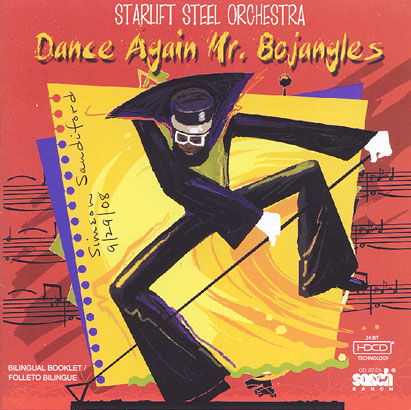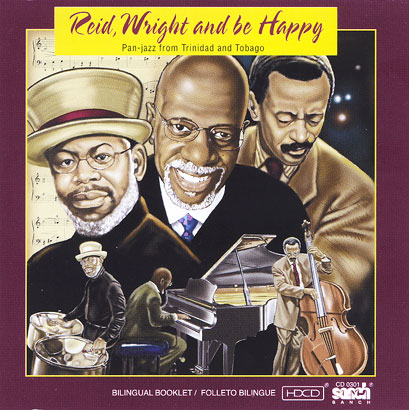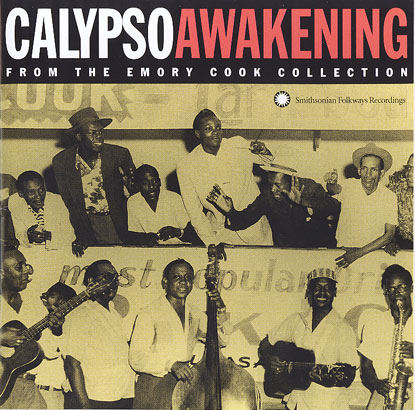Emory Cook
(1913-2002)
By Roger Russell
This
page is copyrighted
No portion of this site may be reproduced in whole or in part
without written permission of the author.
Memories
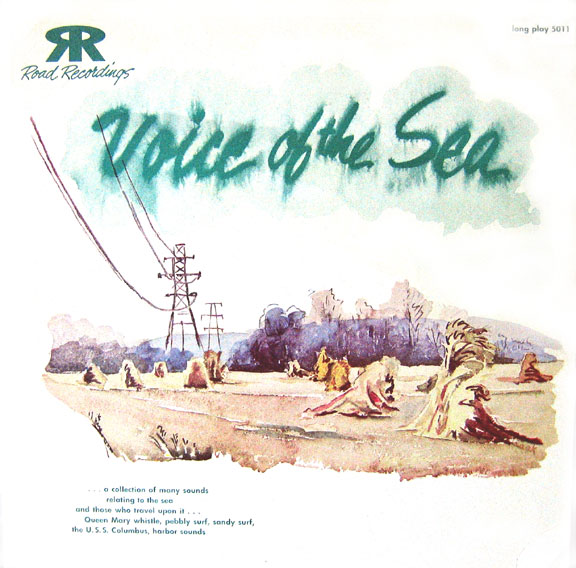
I first heard recordings made by Emory Cook at the New York Audio Fair in the fall of 1954. He was playing Voice of the Sea using an array of Bozak drivers playing the Queen Mary horn full blast. I heard this at the other end of the hall in the Hotel New Yorker and had to see what was going on. Emory had the recordings and Rudy Bozak had the speakers. I ended up buying the recording. At that time, Emory and Rudy had the same address in the following two ads.
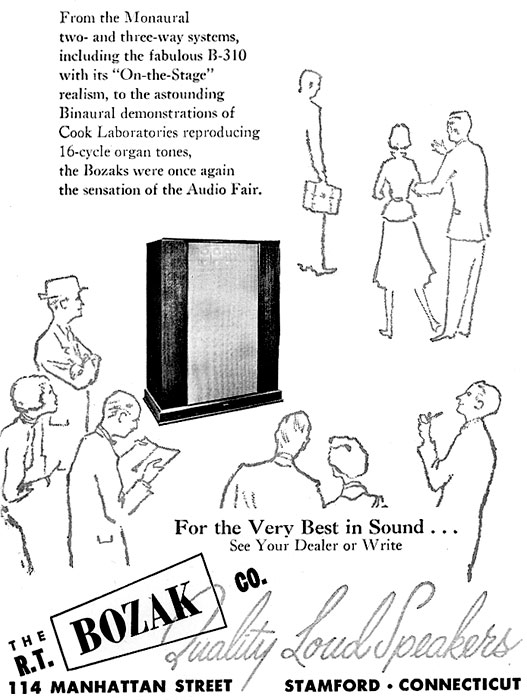
The above ad was in the January-February 1954 issue of
High Fidelity magazine.
The speakers were a pair of Concert Grands having a total of eight 12” woofers.
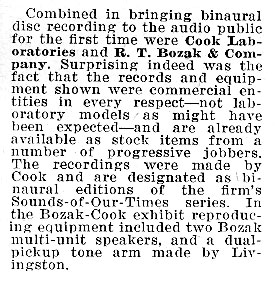
However, the two men had first joined forces for the
Audio Fair back in 1952
This note is from the December 1952 issue of Audio Engineering magazine.
Like Emory, I was also fascinated with sounds and when I was in college he became my idol. That was what I wanted to do was to record all kinds of sounds and play them back as realistically as possible. I started out in the late 1950s with a Viking FF75 stereo recorder and a pair of Telefunken dynamic microphones. I used them to make several recordings of a Wurlitzer pipe organ at a Lowes Theater in New Rochelle. In 1960, Later, I bought a Magnecord 728 professional recorder and followed Emory’s trek to record trains at Harmon, NY, complete with batteries and power inverter in the back of my Volkswagen. I also recorded a few choral and orchestral concerts for friends along with thunder storms, music boxes, bagpipes, player piano, katydids, wind blowing during an ice storm, etc.
I remember talking with Emory at one of the NY Hi-Fi Shows. I was telling him how much I enjoyed his recordings and publication of The Audio Bucket about recording the sound of a caterpillar backing into a wet sponge.
Today, I use a 24-bit pocket digital recorder and in-ear microphones. Headphones or earbuds are used for optimal listening to this recording technique. Of course, the term binaural means hearing with two ears and monaural means hearing with one ear. Listening to a binaural recording with two speakers involves stereo crosstalk where both ears hear the sound from each speaker and is not as accurate. I have not found a reference to Emory ever using a dummy head with in-ear microphones such as those used today by The Sound Tracker, Gordon Hempton or recordings made by the ZBS Foundation.
![]()
Binaural Adapter
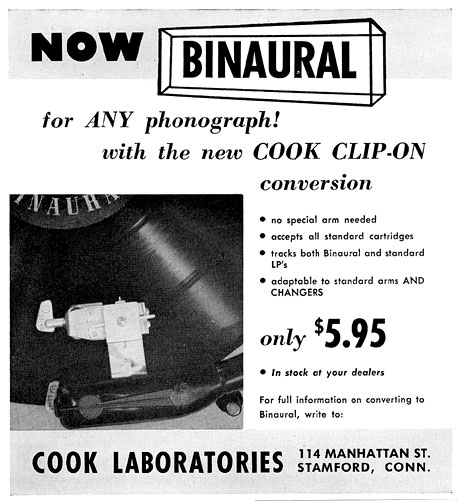
For those who could not afford a binaural arm or could
not
fit it to their turntable or changer, Cook offered the binaural adapter.
The cartridges in the picture appear to be Pickering model 360.
This ad appeared in the March 1954 issue of High Fidelity magazine
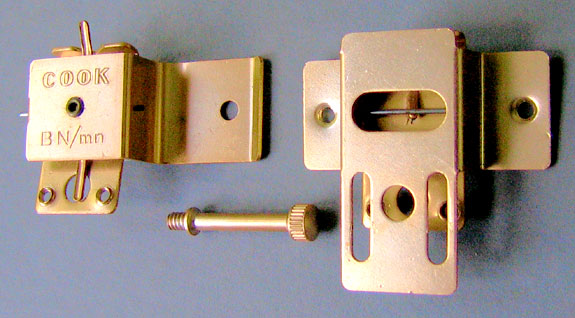
The adapter came in three
pieces. The right hand bracket mounted on the tonearm using the long oval
slots. A plate underneath is where the main cartridge is mounted. The left 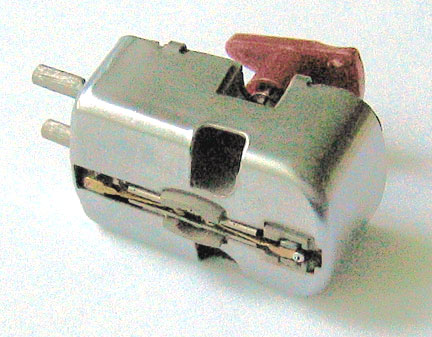 hand bracket is where the second cartridge is mounted.
Both cartridges are then at the same height. The long screw holds the two
pieces together. It also came with a 4-page instruction
sheet. Yes, I bought one and also several more of the binaural records.
Such as Brahms first Symphony, Drums of Trinidad, Nightmare in the Mosque,
Speed the Parting Guest, The Organ in Symphony Hall, etc.
hand bracket is where the second cartridge is mounted.
Both cartridges are then at the same height. The long screw holds the two
pieces together. It also came with a 4-page instruction
sheet. Yes, I bought one and also several more of the binaural records.
Such as Brahms first Symphony, Drums of Trinidad, Nightmare in the Mosque,
Speed the Parting Guest, The Organ in Symphony Hall, etc.
Because the binaural recordings have two separate monophonic bands (inner and outer) the cartridges needed to start playing each channel at the same time. The standard Cook spacing is 1-11/16 inches The small lever in the left hand bracket allows the left cartridge to be moved closer or further away from the main cartridge to synchronize the channel grooves.
I used a pair of GE RPX050 monophonic magnetic cartridges to play the records. I had also used one of them to play LPs as well as 78 rpm records. The red button at the top could be pressed in and the needles could be rotated 180 degrees for either a 1 mil or a 3 mil stylus.
Thanks to Rue Morgue Guitar Repair, Weston, MA for the adapter in mint condition and the instruction sheet.
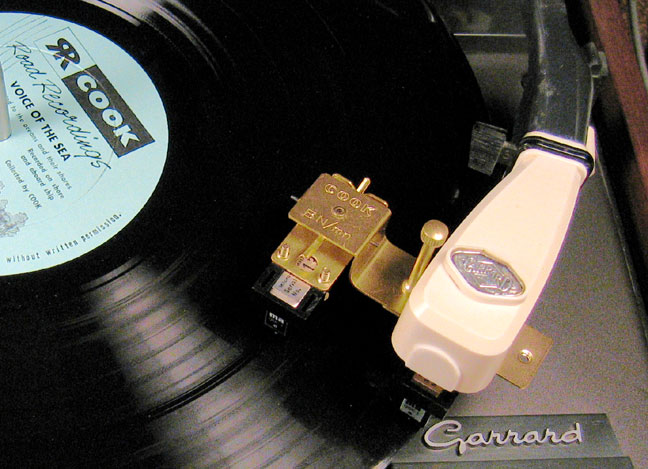
I used the adapter in a Garrard record changer. The Lab Model A came out later and the new shell had enough pins to accommodate stereo a cartridge or two mono cartridge connections. Earlier, a separate shielded wire for the outboard cartridge had to be run along the tonearm to the preamplifier for the second channel. I had to use two mono preamplifiers in the beginning.
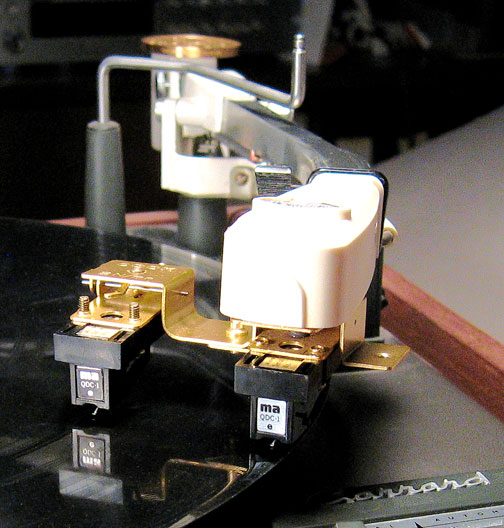
Later, I changed to two Micro-Acoustics cartridges.
![]()
Livingston Binaural Arm
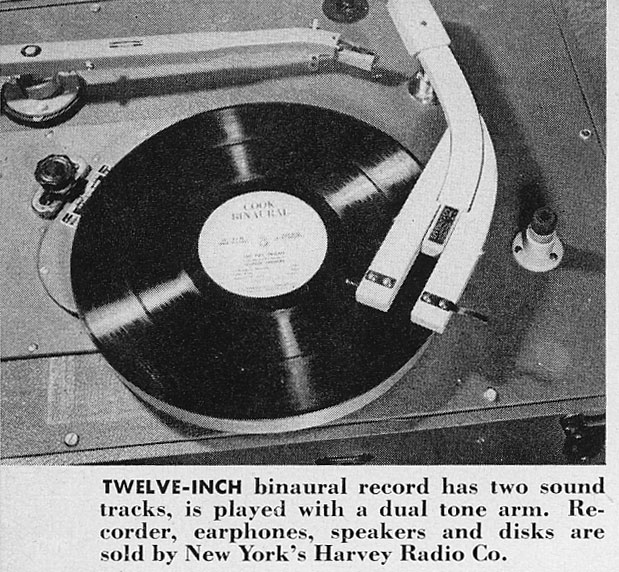
Picture is from Popular Science magazine January 1953
The binaural arm was made by Livingston. It reminded me of a two-headed snake. According to John Hall, a senior engineer at Livingston, Emory had requested to have an arm made to play his dual track binaural records. The prototype was used to broadcast the first stereo record on WQXR in New York City. It now resides in the Audio Engineering Society Museum. Broadcasts back then had one channel on FM and the other was on AM. Two tuners I know of that had separate AM and FM dials were the National Criterion and the McIntosh MR-66. My father had a National and that is how I heard the stereo broadcasts.
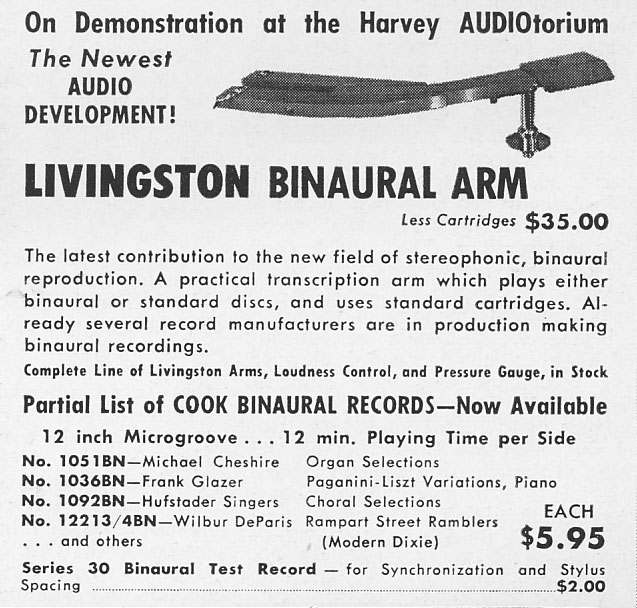
Advertised by Harvey Radio in Audio Engineering magazine December 1952
![]()
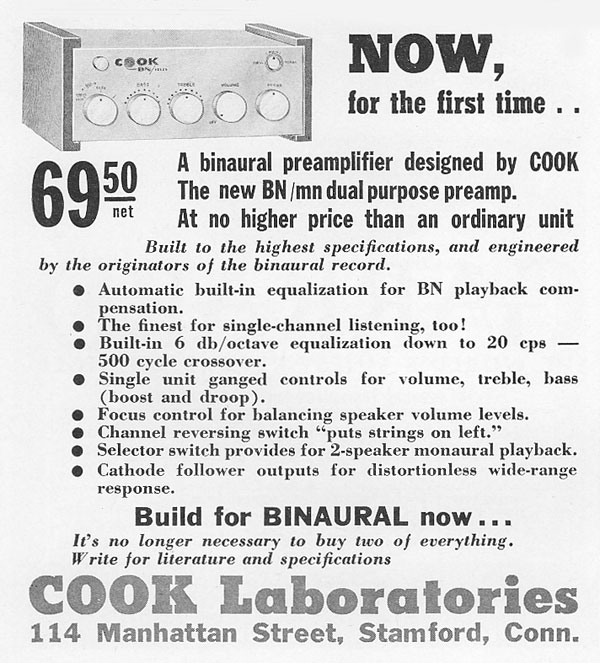
This ad appeared in the May 1953 issue of Audio Engineering.
It is less power supply and is usually connected directly to a power amplifier.
It seems several other companies were joining the binaural bandwagon including a Livingston twin-channel binaural preamplifier plus a power supply and 10-watt/ch amplifier in a matching cabinet all for $149.50. Bell Sound Systems had a Model 3-D 10-watt/ch integrated amplifier with power supply. Bozalk was advertising the B-204 binaural speaker system.
![]()

Of course, I had to have one of these.
The above ad was in the January-February 1954 issue of High Fidelity magazine.

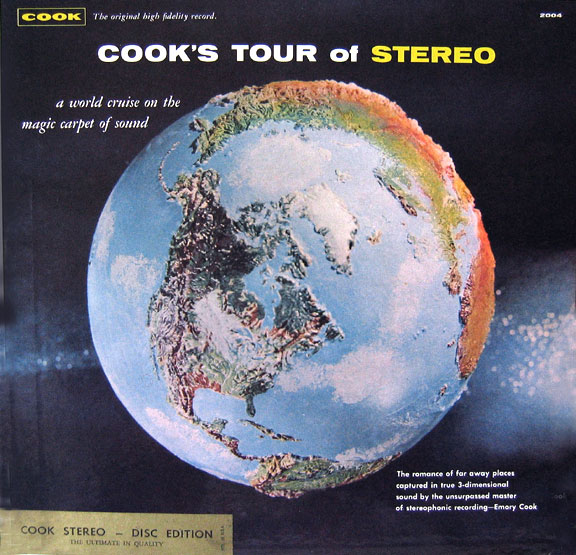
Although my collection is very limited, I did purchase a copy of Cook’s Tour of Stereo. This used the later 45/45 method of cutting. Of course, his Microfusion process was still part of it.
I worked at the Sonotone Corporation in Elmsford, NY from 1959 to 1967. Part of my time was spent in the Audio Products Section and phonograph cartridges. We used the Cook 10” LP test record as well as the CBS STR100 for designing and evaluating cartridges. Emory had also made a custom test record for us.
![]()
Simeon Sandiford
Cook had such a large interest in Calypso music that he set up a second pressing plant in Port-of-Spain, Trinidad. There he pressed calypso and steel band music for both a Trinidadian and American audience, and most albums sold well in both countries. Simeon Sandiford, who lives in Trinidad, did not know Cook but presently also records and issues calypso music. I became acquainted with Simeon while working at McIntosh. He became a McIntosh representative in 1982 after a weeks visit at the lab including, Gordon Gow, Maurice Painchaud, Sidney Corderman and myself. He was very impressed after meeting Jim Carroll. Simeon said he was “the most famous member of the McIntosh sales force.” At the McIntosh clinics, Simeon had seen how Jim had led the customers to trade in equipment made by others or upgrade their older McIntosh equipment for new equipment. Simeon is currently very active in Trinidad for recording and sound reproduction. For an in-depth story about how Simeon became interested in sound and music see The Birth and Life of an Audiophile: A Journey from Entry-Level to McIntosh
|
|
|
Simeon produces his own recordings under the name of Sanch Electronix limited in Trinidad. A couple of the CDs he sent to me are excellent. Mr. Bojangles is an outstanding 24 bit recording using two microphones. The imaging and coherence of the recording is very apparent when played through my speakers.
![]()
Magazine articles about Emory Cook
High Fidelity Magazine article 1954
![]()
Donation to the Smithsonian
The Smithsonian Ralph Rinzler Folklife Archives and Collections acquired the Emory and Martha Cook Collection in 1990, when Emory and Martha Cook donated their company records to the Center for Folklife and Cultural Heritage. Anthony Seeger, then Director of Smithsonian Folkways Records, received a call from Mr. Cook in the summer of 1989 offering to donate the Cook label to the Smithsonian. Dr. Seeger visited him in August of that year to view the contents of the collection, and the Smithsonian received custody of the collection in May 1990. In return for the donation from Mr. Cook, the Center for Folklife and Cultural Heritage agreed to keep the record titles available and to store the papers in the archives. An extensive inventory of Cook recordings and a finding aid can be found at the Smithsonian Center for Folklore and Cultural Heritage
Abstract: Approximately 150 Cook records; 1,069 master tapes of Cook Recordings; 255 folders containing information relating to recordings and business; interview tapes with Emory Cook; objects related to Cook Recordings. Date span: 1939 – 2002. Bulk dates: 1948-1965.
Many of the Cook recordings can be purchased from Smithsonian Folkways
Two of the wide variety of recordings are shown below.
|
|
|
Notes from the Mighty Sparrow Leaflet describe Calypso as:
A humor-coated pellet of uncamouflaged truth,
Taking the opportunity of saying something to somebody in song that you couldn't say in polite society,
An orchid and a sea nymph,
An expression which, having heard, you modestly admit is exactly the way you would have put it yourself, come to think of it,
Satire that makes you laugh because in it is unveiled all that is ludicrous and irrational in a lot of other fellows; sometimes you may even
recognize yourself if you listen hard,
Free association plus improvisation,
Reading a lesson of male supremacy in the face of war, sea, danger,
politics and rum, - in fact in the face of anything except woman,
The dummy for a singing ventriloquist,
Of Trinidad, and Carnival,
Not susceptible
of precise definition.
The logic of calypso and the spirit of Carnival touched this Yankee free spirit
with the same magic that calypso works on anyone who cares to take the time to
try to comprehend the incomprehensible.
Cook Recordings from the Caribbean
ANTIGUA
Steel Band Clash Brute Force Steel Band, Big Shell Band, and Hall Gate
Band (1955) COOK01040
Beauty and the Brute Force Brute Force Steel Band (1957) COOK 01049
Brute Force Steel Band of Antigua with Big Shell Band Brute Force Steel
Band (1955) COOK 01042
Music to Awaken the Ballroom Boast Brute Force Steel Band (19S7) COOK
01048
BRITISH GUIANA
Fate for Sol Tom Charles and His Syncopater Orchestra (1959) COOK 00911
CUBA
jaw bone of an Ass: Musica de Cuba (1955) COOK 01083
Three Rituals (1955) COOK 01043
HAITI
Meringue Ensemble aux Calebasses (1958) COOK 01186
Tiroro: Haitian Drummer Tiroro (1948) COOK 05004
Haiti Confidential Lavinia Williams' Group Folklorique (1958) COOK 01022
JAMAICA
Calypso Jamaica Lord Myrtle, Cecil Mitchel, and James Convery (1960)
COOK 01125
MARTINIQUE
Un Tim Bo Groupe Mi-o (1958) COOK 01021
PUERTO RICO
Island in the Moonlight Trio Los Rubies, Grupo Paquito Lopez Cruz, Las
Hermanas Colon, Martita
Cuadrado (1958) COOK 01121
A Night at the Tropicoro Juan Luis, Oswaldo Soda, and Lito Pefia Band
(1959) COOK 01187
New Paths for Steel Band 10th Naval District Steel Band (1965) COOK
01102
ST LUCIA
Music 0f St. Lucia (1953) COOK 00103
Rada (a branch of Haitian-Dahomean vodun) (1958) COOK 00104
TRINIDAD Afro-West Indian Cultural Practices (1957/58) COOK 00106
Again! Lord Melody Sings Calypso Lord Melody (1957/58) COOK 00914
Bamhoo-tamboo, Bongo, and Belair (1956) COOK 05017 Belly to Belly
Clarence Curvan, Johnny Gomez, Tom Charles, Fitz Vaughn Bryan (1960/61) COOK
00930 The Boli, The Cocolute, and Brazil Escola Be Samba Be Brazil (1957/58)
COOK 00107 Calypso Atrocities (1959) COOK 01123 Calypso
Cross Section Young Killer, the Mighty Bomber, Small Island Pride, the
Mighty Wrangler (1957/58) COOK 00916 Calypso Kings and
Pink Gin: Trinidad Carnival Tent Lord Melody, the Mighty Sparrow, others (1957)
COOK 0118S Calypso Lore and Legend (1956) COOK 05016 Calypso
Through the Looking Glass Lord Melody (1959) COOK 00927
Caribbean Limbo Music Rupert Clemondoro Orchestra, Cyril Diaz Orchestra,
others COOK 01280 The Castilione Johnny Gomez Band, John Buddy Williams
Band, Girl Pat Steel Band, and Grand Curacaye String Orchestra (1956)
COOK 10890 Champion Steel Bands of Trinidad The Highlanders,
Southern All Stars, The Katzenjammers, others (1957) COOK 01046 Dirty
jazz from Down South: Trinidadian Instrumentals (1958) COOK 01188
Drums of Trinidad (1956) COOK 01045 East Indian Drums of
Tunapuna, Trinidad (1956) COOK 050180 The Enchanted Stee lband The
Katzenjammers (1957) COOK 01047 Epiloque to the String Band
Tradition (1956) COOK 05020 Hellish Calypso King Fighter, the
Mighty Bomber, others (1962) COOK 01122 jump-up Carnival: Calypso
Tent (1956) COOK 01072
Le Jazz Primitif from Trinidad Rupert Clemendore and John Buddy Williams
(1961) COOK 01082
King Sparrow's Calypso Carnival The Mighty Sparrow (1959) COOK 00920
Lord Melody Lord Melody (1962) COOK 0931
Lord Melody Sings Calypso Lord Melody (1958/59) COOK 00906
The Ramayana (Hindu Ceremony) (1961) COOK 01023
Three Rituals (1955) COOK 01043
Le Jazz Trinidad Rupert Clemendore Band COOK 10850
Sparrow in Hi-fi The Mighty Sparrow (1963) COOK 01126
VIRGIN ISLANDS
Steel Band in San Juan The Invaders from St. Croix. (1964) COOK
01101
COMPILATIONS
Calypso Exposed Lord Melody, Brute Force Steel Band, King Sparrow, the
Mighty Cypher, and Skipper
(1961) COOK 01189
Caribbeana: Hidden Music from the Caribbean
(1949) COOK 05003
Dance Calypso! Johnny Gomez Band, Small Island Pride, Dictator, others (1956)
COOK 01180
Steel Band Promenade Brute Force Steel Band, the Merrymakers, Southern All
Stars (1958) COOK 01140
SPOKEN WORD
Calypso Lore and Legend (1956) COOK 05016
Grenada Stories and Songs (1957/58) COOK 00101
Jose Ramon Fortune and Olga Comma Maynard Nancy Stories (1956) COOK 00105
|
About This Site |
||
|
|
More text and pictures will be added as my research on this speaker continues. Any comments are welcome. |
|
|
|
|
Created
by Roger Russell |
